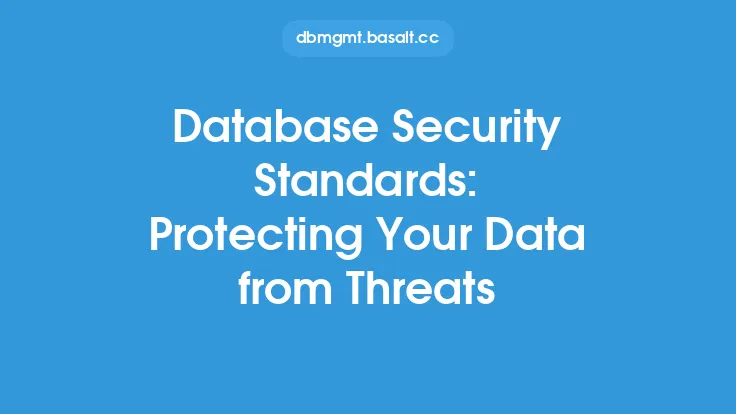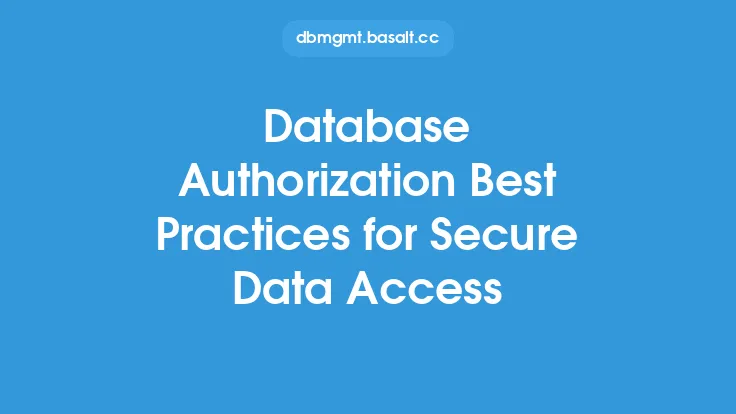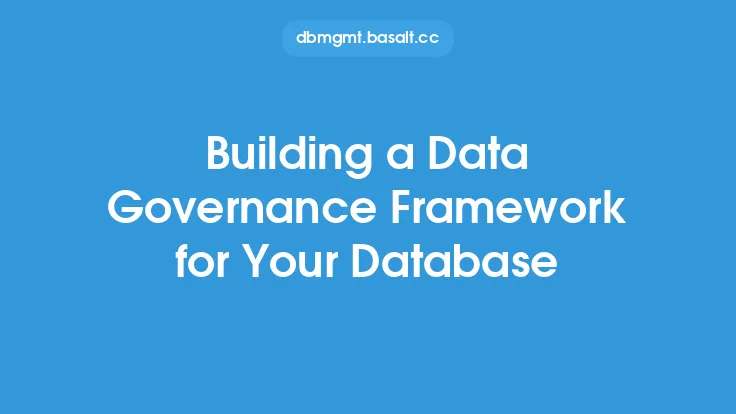As the backbone of modern computing, databases play a crucial role in storing, managing, and retrieving vast amounts of data. However, with the increasing reliance on databases comes the growing concern of protecting sensitive information from unauthorized access. Database security is a multifaceted field that encompasses a range of measures designed to safeguard databases from various threats, including hacking, data breaches, and insider attacks. In this article, we will delve into the essential concepts, best practices, and technical aspects of database security, providing a comprehensive guide for protecting your data from unauthorized access.
Introduction to Database Security Threats
Database security threats can be broadly categorized into two types: internal and external. Internal threats originate from within an organization, often perpetrated by authorized personnel with malicious intentions or accidental actions. External threats, on the other hand, come from outside the organization, typically in the form of hacking attempts, malware, or other types of cyberattacks. Some common database security threats include SQL injection attacks, cross-site scripting (XSS), and privilege escalation. To mitigate these threats, it is essential to implement a robust database security strategy that includes access control, authentication, encryption, and regular security audits.
Access Control and Authentication
Access control and authentication are the first lines of defense in database security. Access control refers to the mechanisms that regulate who can access the database, what actions they can perform, and what data they can view or modify. Authentication, on the other hand, is the process of verifying the identity of users, ensuring that only authorized personnel can access the database. There are several access control models, including discretionary access control (DAC), mandatory access control (MAC), and role-based access control (RBAC). DAC grants access based on user identity, MAC grants access based on user clearance, and RBAC grants access based on user roles. Implementing a robust access control system involves creating and managing user accounts, assigning permissions, and monitoring user activity.
Data Encryption and Masking
Data encryption and masking are critical components of database security, ensuring that sensitive data is protected both in transit and at rest. Encryption involves converting plaintext data into unreadable ciphertext, using algorithms such as AES or RSA. Masking, on the other hand, involves hiding sensitive data, such as credit card numbers or passwords, by replacing it with fictional data. There are several encryption techniques, including symmetric key encryption, asymmetric key encryption, and hash functions. Symmetric key encryption uses the same key for encryption and decryption, while asymmetric key encryption uses a pair of keys: one for encryption and another for decryption. Hash functions, such as SHA-256, are used for data integrity and authenticity verification.
Network Security and Firewalls
Network security and firewalls play a vital role in protecting databases from external threats. Firewalls act as a barrier between the database and the external network, controlling incoming and outgoing traffic based on predetermined security rules. Network security involves configuring firewalls, intrusion detection systems (IDS), and intrusion prevention systems (IPS) to detect and prevent unauthorized access. There are several types of firewalls, including packet filtering firewalls, stateful inspection firewalls, and application layer firewalls. Packet filtering firewalls examine packet headers, stateful inspection firewalls examine packet headers and contents, and application layer firewalls examine packet contents and application layer protocols.
Database Auditing and Logging
Database auditing and logging are essential for detecting and responding to security incidents. Auditing involves monitoring and recording database activity, including user logins, queries, and data modifications. Logging involves recording database events, such as errors, warnings, and information messages. There are several types of database audits, including system audits, application audits, and user audits. System audits monitor system-level activity, application audits monitor application-level activity, and user audits monitor user-level activity. Implementing a robust auditing and logging system involves configuring audit trails, log files, and alert systems to detect and respond to security incidents.
Secure Database Design and Development
Secure database design and development involve creating databases with security in mind from the outset. This includes designing databases with secure architectures, implementing secure coding practices, and testing databases for security vulnerabilities. Secure database design involves creating databases with secure schema, secure data types, and secure relationships. Secure coding practices involve using secure programming languages, secure coding techniques, and secure testing methodologies. Testing databases for security vulnerabilities involves using tools such as vulnerability scanners, penetration testing, and code reviews to identify and remediate security weaknesses.
Database Security Best Practices
Database security best practices involve implementing a range of measures to protect databases from unauthorized access. These include implementing strong passwords, using secure communication protocols, and regularly updating database software. Strong passwords involve using complex passwords, password expiration, and password history. Secure communication protocols involve using protocols such as SSL/TLS, HTTPS, and SSH to encrypt data in transit. Regularly updating database software involves applying security patches, updating database versions, and upgrading database hardware to ensure that databases are protected from known security vulnerabilities.
Conclusion
Database security is a critical aspect of database management, involving a range of measures to protect databases from unauthorized access. By implementing access control, authentication, encryption, and regular security audits, organizations can safeguard their databases from internal and external threats. Additionally, secure database design and development, network security, and firewalls can help prevent security incidents. By following database security best practices and staying informed about emerging threats and technologies, organizations can ensure the confidentiality, integrity, and availability of their data. As the threat landscape continues to evolve, it is essential to stay vigilant and proactive in protecting databases from unauthorized access, ensuring the security and reliability of critical data assets.





